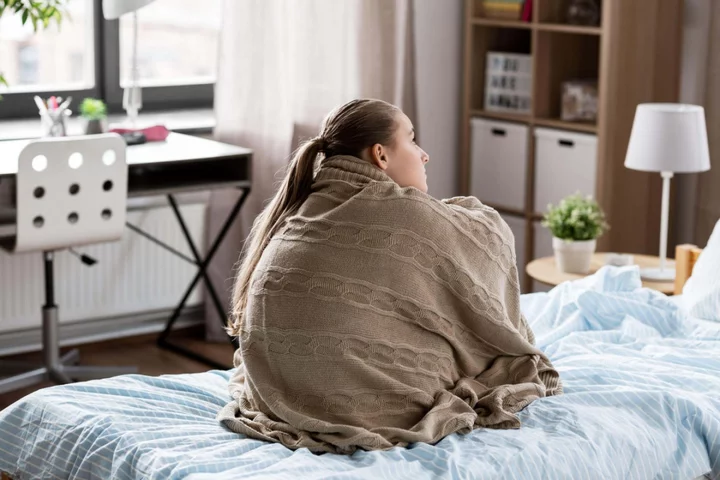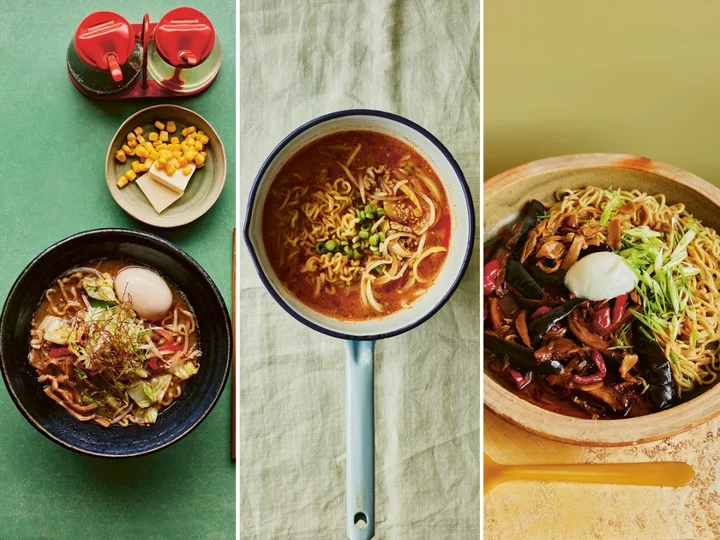
Hibernation mode: 5 small self-care adjustments to make before the clocks change
With the clocks going back on October 29, longer, darker nights are imminent – and many of us may be nervous about how this could impact our wellbeing. But, there are some little acts of self-care that could help. Here’s how to switch up your self-care routine as the clocks change… 1. Spend more time outdoorsIt may be getting colder, but time outside could be the best thing for you to protect your emotional welfare as the shorter days draw in. “When the clocks change, the internal body clock, our circadian rhythm, has to reset and it can become out of sync with our standard night-and-day cycle. It can take a few days for our body to adjust to the new sleep pattern, which can affect our hormones and temperature,” explains Dr Harriet Leyland, clinical advisor at myGP. To mitigate this, “spend more time outdoors”, she suggests. “Sunlight can alleviate drowsiness as it limits the release of melatonin, a hormone that induces tiredness and gets you ready for bed.” Jodie Relf, a Pilates instructor and registered dietitian from myOva, suggests making this part of your daytime routine. “[Getting outside] can be more challenging once the clocks have changed, it’s often dark for many of us both going to and returning from work. Therefore trying to get outside during the day, at lunchtime, perhaps, can be beneficial in the winter months,” says Relf. 2. Think about your body temperatureYou may be feeling the cold outside, but we don’t want to overheat indoors – especially at bedtime. “We sleep better in a cooler environment, with the ideal bedroom temperature reported to be a cool 16-17C,” says Dr Guy Meadows, co-founder and clinical lead at Sleep School. “For best sleep, switch off the central heating and swap your lightweight summer duvet for a higher tog winter one. Alternatively, use a combination of sheets, quilts and blankets, as this allows you to more easily regulate your temperature at night for better sleep.” 3. Prepare for good sleepIf you always struggle with sleep when the clocks change, give yourself a helping hand by being prepared. “Gradually adjust your bedtime in the few days leading up to the clocks changing – go to bed 15-30 minutes earlier each night for a few nights in the lead-up,” suggests Meadows, explaining this will help with the body-clock switch. 4. Eat a colourful plate While you may just want stodgy comfort food to warm the chillier evenings, eating well is one of the best ways to support your overall wellbeing – aiding energy, immunity, mood and sleep. “Eat a balanced diet with a colourful variety of plant foods including fruits, vegetables and whole grains, as well as lean protein,” explains Dana Moinian, a psychotherapist at The Soke. “Avoid heavy or high-sugar meals close to bedtime.” 5. See friends While social plans may have wound down compared with summer, hibernating and distancing yourself too much could be damaging to your wellbeing. “Spend time with friends and loved ones,” says Moinian. “Socialising naturally boosts your mood and reduces stress levels.” So get the diary out and plan in some fun outings and get-togethers! Read More 13 possible cancer symptoms you should get checked out Neglecting women’s health at work could cost UK economy £20.2bn a year – analysis Nearly three-quarters of mothers feel invisible, study suggests The best ways to work-out in 22 minutes – as study finds this is magic number for offsetting ‘negative impact of sitting’ What crops will we be growing in the future, as climate change alters the landscape? As Rebecca Adlington shares heart-breaking miscarriage news: How to support others experiencing baby loss
2023-10-26 14:27

Three ramen recipes to change your life
“The more ramen I eat, the more I’m drawn to miso ramen,” says chef Tim Anderson. “Thanks to its complex tare and the many textures found in its stir-fried veg topping, it’s just so damn interesting. Cooking and plating are a little different for this one, so make sure you read the method below.” Miso ramen Ingredients: For the broth (makes around 2.4L)): 2 tbsp vegetable oil or animal fat 50g fresh ginger root, thinly sliced 1 onion, quartered 1 garlic bulb, halved 250g chicken skin 250g chicken feet 800g chicken wings 1.5kg chicken frames, roughly chopped ≈3.5L water 4 bay leaves (optional) ½ tsp white pepper For the miso tar (makes 400g): 150g red miso 100g white miso 50g brown rice miso 2 tbsp vegetable oil or animal fat 1 onion, finely chopped 4 garlic cloves, finely chopped 20g fresh ginger root, peeled and finely chopped 6 tbsp sake 1 tbsp sesame oil 1 tbsp sesame seeds, crushed 4 tbsp single cream 4 tbsp Ovaltine or malt powder 30g parmesan or mature cheddar, finely grated 1 tbsp shoyu For the garlic sesame oil (makes 80ml): 45ml vegetable oil or lard 60ml sesame oil 30g garlic (about 8 cloves), very thinly sliced For the toppings (makes enough for 4 bowls): 1 tbsp lard or vegetable oil ½ an onion, thinly sliced 100g minced meat (pork is typical but chicken, turkey or vegan mince work, too) ¼ of an hispi or flat cabbage, cored and coarsely chopped ½ a small carrot, cut into planks about 3mm thick A big handful of bean sprouts A few mangetout ¼ of a red pepper, thinly sliced A small pinch of salt and/or MSG (optional) 1 tsp sesame oil, or aroma oil of your choice Menma (tinned bamboo shoots) Shredded spring onions (scallions) or leeks Shop-bought noodles Optional toppings: Corn Butter Chilli oil Spinach or wakame Parmesan Beni shÅga (red pickled ginger, sharp, sweet and artificially coloured. Good with tonkotsu) Sesame seeds Ajitama (ramen egg) Method: 1. Make the broth: Heat the oil or fat in a roasting tray in a fan oven set to 200C (425F), then add all of the vegetables and chicken parts and roast for 40 minutes, turning everything once halfway through cooking. Remove the vegetables with tongs and set aside. Tip the chicken parts and any drippings from the tray into a stock pot and add the water (enough to cover) and bay leaves, and set over a high heat. Boil hard for four hours, topping up the water as needed to maintain the water level. After four hours, add the veg and the white pepper, and continue to boil for another two hours. In the final hour, stop topping up the water and allow it to reduce slightly. Remove from the heat, then bring back to a high simmer if using immediately. Remember to re-emulsify the broth with an immersion blender before serving. 2. Make the miso tare: Stir together the three types of miso until well mixed. Heat the oil or fat in a small saucepan over a medium-high heat, then add the onion, garlic and ginger. Sauté for about 10 minutes, stirring often, until everything softens and begins to colour, then add roughly half of the miso mixture and continue to cook for another seven to eight minutes, until the miso darkens as well. Whisk in the sake and boil for three to four minutes to cook off the alcohol, then add the sesame oil, sesame seeds and the cream. Bring to the boil and cook for another three to four minutes, stirring often. Remove from the heat, leave to cool for a few minutes, then whisk in the Ovaltine, cheese, shÅyu and remaining miso mixture. Transfer everything to a blender or food processor and process until smooth. 3. Make the garlic sesame oil: Pour the vegetable oil and one tablespoon of the sesame oil into a small saucepan and stir in the garlic, ensuring that none of the slices are stuck to each other. Set over a low heat and cook gently for about 15 minutes, stirring often, until the garlic is evenly golden brown (the reason for keeping the heat low is to cook off all of the garlic’s moisture before it begins to colour). Once the garlic is lightly browned (we’re looking for gold, not bronze), remove it with a slotted spoon, fork or similar, drain on paper towels and leave to cool. Leave the oil to cool for about 10 minutes, then tip into a jar and add the remaining sesame oil. Once the garlic chips have cooled, crush them into small pieces and keep in an airtight container lined with paper towels. 4. Make the toppings: Have all of your veg prepped and ready to go, because the cooking here should be very quick. In a wok or frying pan, heat the lard or oil over a high heat and add the onion and mince and stir-fry for a couple minutes, then add the cabbage and carrot and continue to stir-fry for two to three minutes until everything is wilted but still crunchy. Add the bean sprouts and mangetout and continue to stir-fry for another two to three minutes, then add the pepper and salt and/or MSG (use this sparingly, or not at all, if you’re going to boil the mixture in seasoned soup). Stir-fry for a further two minutes or so, then remove from the heat and stir in the sesame or aroma oil. 5. Build the ramen: You can build this bowl as you would any other ramen, but I think it’s tastier the way many shops in Sapporo do it, which is to combine everything in a wok and then transfer it to the bowl. Start with the stir-fry and when it’s done, stir in the tare, then the broth. Whisk to combine and bring to the boil. Meanwhile, cook the noodles in a separate pot of boiling water, and when they’re done, drain well and tip them into bowls. Pour the broth from the wok over the noodles along with the stir-fried and boiled veg, keeping the veg on top of the noodles as you portion them out. The fat can either be added to the bowl or to the wok; if you add it to the wok it will become emulsified with the broth upon boiling, but it will taste the same. If topping with butter and corn, add cold butter at the last minute, just before serving. ‘Nothing special’ ramen “Sometimes the ramen craving strikes and there’s no ramen to be found – what do you do? Instant ramen does the job, of course, and some of it is excellent, especially if you’re able to add good toppings,” says Anderson. “But even that is sometimes unavailable. This recipe is designed to tick the proper ramen box from common refrigerator and store cupboard ingredients – when you don’t have any good broth, nor tare, nor oils, nor nothing!” Serves: 1 Ingredients: 20g lard 80g minced pork 2 anchovies ½ an onion, thinly sliced A big handful of bean sprouts 2 garlic cloves, grated 1 tbsp sesame oil 2 tbsp red miso 1 tbsp sugar 1 tbsp white wine 1 tbsp tomato purée 2 tbsp shÅyu 1 tbsp peanut butter or tahini A pinch each of white pepper and smoked paprika 500ml water 1 tbsp grated parmesan or cheddar 1 portion shop-bought noodles A big pinch of sesame seeds 1 spring onion, thinly sliced Chilli oil, to taste (optional) Salt, to taste Method: 1. In a wok or medium saucepan, melt the lard over a high heat and add the pork mince, anchovies and onion. Stir-fry for a few minutes, breaking up the anchovies as you go, until the pork is cooked through and the onion has begun to soften. Toss in the bean sprouts and garlic and stir-fry for another one to two minutes, then tip everything out into a bowl. 2. Add the sesame oil to the pan and set over a medium heat, then add the miso and sugar and fry it for a few minutes until the aroma becomes rich and caramel-like. Stir in the white wine, tomato purée, shÅyu and peanut butter or tahini and cook for another few minutes, then add the pepper, paprika, water and cheese. 3. Bring to the boil, add the noodles and cook them to your liking. Once they’re done, taste the broth and add salt or more water as needed – different noodles will absorb different amounts of liquid, so you’ll have to adjust for this accordingly. 4. Transfer the broth and noodles to a bowl and top with the stir-fried mince and veg and garnish with the sesame seeds and spring onion. Add as much chilli oil as you like. Yu Xiang aubergine mixed noodles This recipe is inspired by aburasoba – a soupless ramen dish where the noodles are served in a bowl with tare (dipping sauce) and oil at the bottom and toppings on top, which is then mixed together at the table. “I’m tempted to call it an aburasoba… but it would not resemble any aburasoba I’ve seen in Japan,” says Anderson. “Aw heck, let’s just say it’s mixed noodles and call it a day!” Serves: 2 Ingredients: 1 large or 2 small dried shiitake mushrooms 150ml just-boiled water 1 large aubergine Oil, as needed for shallow-frying 1 tsp cornflour 2 tbsp shÅyu 1 tbsp dark red miso (such as HatchÅ miso) 1 tbsp oyster sauce 2 tbsp Chinkiang vinegar, Japanese black vinegar or similar, plus extra to taste 1 red pepper or a handful of small, sweet peppers, thinly sliced 2 garlic cloves, finely chopped 15g fresh ginger root, peeled and finely chopped 1-2 dried red chillies, or a few pinches of chilli flakes (to taste) 3 tbsp light brown sugar 1 tbsp sesame oil 2 portions noodles 2 spring onions, thinly sliced at an angle 2 egg yolks 50-60g Menma or tinned bamboo shoots Chilli oil, to taste Method: 1. Place the shiitake mushrooms in a small dish and cover them with the boiled water, then leave to rehydrate for about an hour. Meanwhile, cut the aubergine into batons or prisms about 2cm thick, and pour the oil into a large frying pan or wok to a depth of about 1cm. 2. Heat over a medium-high heat for a few minutes, then test the temperature by placing a piece of aubergine into the oil. If it sizzles vigorously immediately, the oil is ready. Add all of the aubergine to the oil and fry for about five to six minutes, turning often, until richly browned all over. Remove with a slotted spoon or spider and drain well on paper towels. Tip the oil out into a heatproof container, but leave about one tablespoon oil or so in the pan. 3. Once the mushrooms have rehydrated, remove their stems and cut them into thin slices. Stir the cornflour into the resulting mushroom dashi and stir together the shÅyu, miso, oyster sauce and vinegar in a separate bowl until no lumps of miso remain. 4. Ensure you have all of your prep ready to go before cooking, because the pace needs to be fairly quick once you begin. Place the pan with the reserved one tablespoon oil back over a high heat. Once the oil is shimmering, add the peppers and stir-fry for two to three minutes until browned. 5. Add the garlic, ginger and chillies, and stir-fry for another one to two minutes, then add the sliced shiitake mushrooms and sugar and stir-fry briefly so the sugar melts and bubbles. 6. Add the liquid seasoning mixture and stir well, then add the cornflour and mushroom dashi mixture and bring to the boil so it thickens. Finally, tip in the fried aubergine and stir well to coat. Reduce the heat to low to keep warm while you cook the noodles. 7. Divide the sesame oil between the two bowls and add a few spoonfuls of the aubergine sauce to each one. 8. Boil the noodles until tender, then drain well and tip into the sauce. Stir the noodles through the sauce, then top with the aubergine and its sauce, and garnish with the spring onions, eggs and menma. Serve with chilli oil and extra vinegar – add as much as you like. ‘Ramen Forever: Recipes For Ramen Success’ by Tim Anderson (Hardie Grant, £26). Read More World Pasta Day: Nigella Lawson’s spaghetti with Marmite This speedy king prawn pasta has a supermarket secret weapon Midweek meals: Baked pasta Siciliana with meatballs How to make a classic lasagne Dear Pret, this is what a £7 sandwich should look like Jack Stein’s Cornish mussels with spinach and cider
2023-10-26 13:51

Kylie Jenner says she and ex Travis Scott are doing ‘the best job that they can do’ as co-parents
Kylie Jenner has shared a rare comment about co-parenting with her ex, Travis Scott. The 26-year-old model spoke candidly about her and Scott’s children – Stormi, five, and Aire, one – during an interview with The Wall Street Journal Magazine, published on 24 October. When asked about co-parenting with the rapper, she said: “It’s going…. I think we’re doing the best job that we can do.” Scott and Jenner first started dating in 2017 and had an off-and-on relationship until January 2023. At the time, a source claimed to Us Weekly that the pair were “off again,” after rekindling their romance for a second time in February 2020. However, the publication also claimed that the former couple was still on good terms, adding: “This has happened so many times before, they’re known to be on-again, off-again, but always remain friends and great co-parents.” Since their split, Scott has shown his support for his ex. In April, he took to the comments of one of her Instagram posts and wrote: “A beauty.” However, fans came up with a different theory in July, with claims that a reference in his song, MELTDOWN”, was about Jenner’s new relationship with Timothée Chalamet, who she’s been romantically linked to since May 2023. At the end of the song’s second verse, Scott raps the lines: “Chocolate AP and chocolate the Vs got the/ Willy Wonka factory (Vs)/ Burn a athlete like it’s calories find another flame/ hot as me, b****.” The mention of Willy Wonka is seemingly in reference to Chalamet’s leading role as Roald Dahl’s famous fictional chocolatier in the forthcoming musical feature film, Wonka. During her interview with WSJ Magazine, the reality star also spoke candidly about motherhood, and how her perspective on beauty standards has changed while raising Stormi. She also described some of the lessons she’s teaching her daughter. “My daughter has totally taught me a lot more about myself, and seeing myself in her has changed everything. I’ve had so much growth and am just embracing natural beauty,” she said. “I’m teaching her about mistakes that I made and making sure she knows she’s just perfect exactly how she is.” The Kardashians star specified that some mistakes she’s made over the years have included getting “surgery when [she] was younger”. She added that while she’s never gotten work done on her face, she still decided to have a breast augmentation, which she’s previously been open about. “But just even getting my breasts done when I was 19 and getting pregnant soon after, not obviously planning to be pregnant at 19,” she said. “And I was never insecure about myself. I actually was always super confident and loved my body. I was just having fun. I was influenced by amazing boobs and was like, that’s what I wanted to do, and had fun with it.” According to the Kylie Beauty founder, her experiences can be lessons for her children. “I probably just should have waited until I maybe had kids or let my body just develop,” she said about the procedure, before adding that motherhood is about “teaching our kids to do better than us, be better versions of who we were”. During the interview, she also spoke about legally changing her son’s name from Wolf Jacques to Aire in 2023, one year after he was born. “That was the hardest thing that I’ve ever done in my life,” she said. “I’m still like: ‘Did I make the right decision?’” She also explained how difficult it was for her to come up with her son’s name shortly after giving birth. “The postpartum hit, and the hormones, and I couldn’t even make a decision or think straight,” she added. “And it just destroyed me. I could not name him. And I was like: ‘I feel like a failure. I don’t have a name for my son.’ So it took me a while. And then the longer I waited, the harder it was to name him.” Read More Timothée Chalamet compares Kylie Jenner romance to Harry-Meghan South Park episode Gym maths: How to optimise 22 minutes exercise a day according to fitness experts Chris Pratt sparks relatable parenting debate about childhood trophies Gym maths: How to optimise 22 minutes exercise a day according to fitness experts Chris Pratt sparks relatable parenting debate about childhood trophies Jasmine Harman tearfully recalls mother’s struggles with hoarding
2023-10-26 04:47

Bud Light to return as the UFC's official beer next year as it recovers from a conservative backlash
Bud Light is set to return as the official beer of the UFC in the U.S. next year as the brand tries to recover from a conservative backlash to a promotion with a transgender influencer
2023-10-26 04:29

Scholastic will drop policy that makes it easier for school fairs to exclude diverse books
Scholastic Inc. will end a widely criticized policy that made it easier for school book fairs not to sell works with racial, disability and LGBTQ+ themes
2023-10-26 03:57

Apple raises prices for Arcade gaming subscription service, AppleTV+ streaming
Apple Inc. is raising the prices for its AppleTV+ streaming and Arcade gaming plans as well as its bundled Apple One service that includes streaming, music and other subscriptions
2023-10-26 02:26

Beer belly wrestling, 'evading arrest' obstacle course on tap for inaugural Florida Man Games
It ain’t the Olympics, but a group of Floridians plan to host competitions themed according to the collective antics of the beer-loving, gator-possessing, rap-sheet heavy, mullet-wearing social media phenomenon known as “Florida Man.”
2023-10-26 00:16

Chris Pratt sparks debate over when parents should throw away childhood trophies
Chris Pratt has asked the question almost every parent wonders when raising their children: Is it okay to throw away childhood trophies? The Guardians of the Galaxy star, 44, recently posed the question to his social media followers after he and his wife, Katherine Schwarzenegger, came across all her childhood trophies kept by her parents, Arnold Schwarzenegger and Maria Shriver. Pratt took to Instagram on 24 October, where he shared several photos of the children’s book author, 33, holding up some of her many childhood trophies - including “Problem Solving Super Star 4th Grade 2000” and “most improved two-year-old in swim class”. In the lengthy caption, the Parks and Recreation alum explained that Schwarzenegger’s mother had been “storing special items” from her daughter’s childhood for years, which he noted was “so very thoughtful”. “To see my darling wife beaming with sentiment as she opens these crates of meticulously organised keepsakes, remembering her cherished youth, makes me grateful for the efforts her folks put into archiving,” Pratt wrote. “I suppose that’s the payoff for the work it took to store this stuff, the smile on her face as she relives moments of her youth. To pray one day that your children will look back on their childhood with glee is a blessing. It is the hope of parenthood.” However, as the couple - who have been married since 2019 - perused Schwarzenegger’s prized possessions, it got him thinking about how long he’s supposed to hold onto his own children’s mementos. Pratt shares an 11-year-old son, Jack, with ex-wife Anna Faris and two daughters - Lyla, three, and Eloise, one - with Schwarzenegger. “Real talk,” Pratt said. “Once your kid goes through the stuff, is it okay to toss? I mean… do we need the ‘I was on a sports team trophy?’ Can they be donated? Repurposed? How many do we gotta keep? Not all of them right? Any of them? Is there a grading scale? Like, did you win? Were you a champion? Is there a specific sentimental connection? Help me out here. Do they go back in storage?” His relatable question prompted many parents in the comments section to sound off on how long they’ve kept their children’s trophies. Some users admitted that they wished their own parents had held onto their accolades for so long. “Wait this is amazing. I’ll be saving my children’s stuff for sure,” one person commented. “Well, I have no keepsakes from childhood and I wish I did. So there is that,” another said. “I had my boys go through their boxes and they kept what was special to them. I tossed the rest,” a third fan wrote. “FREEDOM!!!” Others revealed what they did to cherish their children’s precious memories while still saving some room in the storage bin. “I donated all my old trophies to an organisation that removes the labels and repurposes them for fun awards,” wrote one fan. “For those sentimental ones, we peeled off the engraved part and kept it in a plastic pocket notebook and tossed the trophy part,” said someone else. Another user suggested: “Give them out as prizes when your friends come over for game night.” Meanwhile, Schwarzenegger joked that her husband was simply jealous she’s acquired so many trophies over the years. “Feels like someone is a litttlllee bit jealous of my natural athleticism from birth and ability to solve problems,” she commented. Pratt’s mother-in-law also weighed in on the debate, as she applauded herself for saving almost every prized possession for her four children. “Omg I’m so happy,” Shriver commented. “Here’s to story trophies and school work and dresses and party outfits I feel vindicated.” The Jurassic World star was married to Faris in 2009. The former couple announced their split in August 2017 and finalised their divorce in October 2018, four months after he began dating Schwarzenegger. He proposed to the author in January 2019 and they were married in June that year. Pratt has often shared glimpses into his life as a father of three on social media. Most recently, he went viral when he posted a photo of the glittery makeover he received from his two daughters. He shared two photos of his new look, including one where his forehead was bedazzled with teal, purple, and silver gems. The other photo showed Pratt with pearl-like gems dotting his face, as well as a teal manicure. “All I have to say is… Jack would never do this to me,” he captioned the post. Read More Gym maths: How to optimise 22 minutes exercise a day according to fitness experts Jasmine Harman tearfully recalls mother’s struggles with hoarding Neglecting women’s health at work could cost UK economy £20.2bn a year – analysis Gym maths: How to optimise 22 minutes exercise a day according to fitness experts Jasmine Harman tearfully recalls mother’s struggles with hoarding Neglecting women’s health at work could cost UK economy £20.2bn a year – analysis
2023-10-25 22:52

Watch for these 3 Medigap shopping surprises to avoid overpaying
Medicare Supplement Insurance, or Medigap, can help pay for Medicare Part A and/or Part B copays, coinsurance and deductibles, but shopping for plans isn’t always straightforward
2023-10-25 21:56

Jasmine Harman tearfully recalls mother’s struggles with hoarding
TV presenter Jasmine Harman became emotional as she opened up about her mother’s struggles with hoarding – and how it adversely impacted their relationship for years. The host of Channel 4’s A Place in the Sun, Harman, 47, said she “refused to bring people home” and was “really, really embarrassed and ashamed” about her mum Vasoulla’s condition, on Wednesday (25 October) during an appearance on This Morning. “In fact, when I started working in television, it was my biggest fear that someone would find out about the way I’d grown up and the way that we lived at the time,” she told Dermot O’Leary and Allison Hammond. Reflecting on how things had changed since then, Harman teared up as she affirmed her priority is “having a loving relationship” with Vasoulla – and not “focussing on the hoarding” anymore. Addressing her mother, Harman added: “She’s helped me to become a much more compassionate person. We used to fight, didn’t we? “But now we have a relationship that’s outside [of the hoarding].” Hoarding was recognised as a mental health disorder in 2013. According to the World Health Organisation (WHO), it is characterised by “an accumulation of possessions due to excessive acquisition of, or difficulty discarding possessions, regardless of their actual value”. The Diagnostic and Statistical Manual of Mental Disorders (DSM) outlines detailed criteria that psychologists can use to diagnose hoarding, including cluttered living spaces where the room’s intended use [of cooking, sleeping, or sleeping] has become impossible. These behaviours usually appear during a person’s early life, with Vasoulla explaining it was triggered by “the trauma of loss” in her case. “We moved from Cyprus when I was about three so I left my baby things back home and started collecting trinkets in bombed-out houses that were still about in the early Sixties, after the war – trinkets that I treasured,” she explained. “Then we moved back to Cyprus for a couple of years and those things all got lost. Then we moved back to England and all my new ties got lost – so I just had lots of upheaval, lots of loss.” Vasoulla, whose father was killed in Cyprus, added: “It’s more the loss, like a bereavement. Losing your father is a big thing, moving country ...you lose everything and you get a new place to live. The trauma of loss [is] something that a lot of people have as the onset of their hoarding behaviour.” The mother-daughter duo previously opened up about how hoarding affected their lives in a 2011 BBC documentary, titled My Hoarder Mum & Me. Speaking about the “cathartic experience”, Harman on Wednesday confessed:“I genuinely had no idea how many people were affected by this.” Around three million people are reportedly impacted by the mental health condition, according to Hoarding Disorders UK. The organisation’s director Jo Cook, who joined Vasoulla and Harman on the This Morning couch, explained that hoarding is neither a lifestyle choice, nor “about poor housekeeping”. When asked about supporting loved ones who might struggle with hoarding, Cook recommended joining a support group and approaching the anxiety-based disorder with empathy. “It’s really important that that person that you’re helping, feels safe in their home with you. Because, essentially, you’re unpicking someone’s nest, so you need to make sure you’re doing it slowly and surely,” she added. If you have been affected by this article, you can contact the following organisations for support: actiononaddiction.org.uk, mind.org.uk, nhs.uk/livewell/mentalhealth, mentalhealth.org.uk. Read More Pete Davidson is on the market for a hot date - but not for him Gym math: How to optimise 22 minutes exercise a day according to fitness experts Neglecting women’s health at work could cost UK economy £20.2bn a year – analysis Gym math: How to optimise 22 minutes exercise a day according to fitness experts Neglecting women’s health at work could cost UK economy £20.2bn a year – analysis Nearly three-quarters of mothers feel invisible, study suggests
2023-10-25 21:46

Neglecting women’s health at work could cost UK economy £20.2bn a year – analysis
Neglecting women’s health in the workplace could be costing the UK economy around £20.2 billion each year, analysis has suggested. In a new survey of 2,000 women, 68% said that they have dealt with health issues at some point in their career, whilst almost 29% felt their employers were not supportive. When factoring in specific health matters that relate to women, including endometriosis, fertility, menopause and periods, this figure increases to 36%, leaving 46% of women worried that their health could impact their career trajectory and 48% thinking they would be forced to resign. The study conducted by AXA Health in partnership with the Centre of Economics and Business Research (CEBR) also suggested that 83% of women have had their personal finances affected when faced with health issues. For instance, 52% of women have had to take time off, 22% missed out on a promotion and 20% settled for lower pay. Economic modelling from AXA Health and CEBR suggested that ignoring women’s health at work could be costing the UK economy £20.2 billion a year. From 90% of women struggling emotionally, 46% feeling helpless and 43% feeling less motivated at work, this issue has also had a huge impact on their mental health and wellbeing. “As this report finds, neglecting the health of women in our workplaces isn’t just a matter of compassion; it’s a serious economic oversight,” said Flick Drummond MP, who is serving as the co-chair of the All-Party Parliamentary Group on Women and Work. Dr Pallavi Bradshaw, deputy chief medical officer at AXA Health, added: “While companies certainly still have a way to go in addressing women’s health at work, there is promise in the increased willingness of women to discuss their health concerns with colleagues and managers.. “For example, our women’s health report found that 60% of women who talked about their health found their employers to be supportive, whether this be through time off, offering counselling or making adaptations to the workplace. “These developments are positive, but as we delve further into the findings, it becomes evident that concerns extend beyond just health issues. A striking 53% of the women we surveyed voiced that, within their workplaces, women often shoulder more unplanned responsibilities – such as caring for loved ones – than their male counterparts. “Furthermore, when reflecting on their own families, 39% of respondents revealed that they bear a greater burden than male family members when it came to unexpected caring responsibilities. This gender-based imbalance in unpaid labour not only perpetuates inequality but also places women at risk of being sidelined in their careers, overlooked for promotions, or compelled to work beneath their true potential.” Bradshaw said the economic impact of neglecting women’s health is “still significant”, and urged the need for “more education, robust workplace policies and talent retention initiatives”. The report suggested women who work part-time are hit even harder when it comes to health-related issues. It found that 61% are worried about having to leave their jobs prematurely, which exceeds the average by 19%. Only 17% of women who work full-time believe that conversations surrounding women’s health are not encouraged in their workplaces, but this increases to 23% for those who are employed part-time. According to a report conducted by The Royal College of Obstetricians and Gynaecologists, women represent 51% of the population and 47% of the workforce. Read More Nearly three-quarters of mothers feel invisible, study suggests The best ways to work-out in 22 minutes – as study finds this is magic number for offsetting ‘negative impact of sitting’ What crops will we be growing in the future, as climate change alters the landscape? As Rebecca Adlington shares heart-breaking miscarriage news: How to support others experiencing baby loss What you need to know about new research into treating cervical cancer How to do Halloween make up and still take care of your skin
2023-10-25 19:57

Nearly three-quarters of mothers feel invisible, study suggests
Most women feel ‘invisible’ and ‘unappreciated’ when they become mothers, new research has revealed. Instead of ‘having it all’, 72% of mums feel invisible and 93% feel unappreciated, unacknowledged or unseen once they’ve had children. Another 93% said that since having a child, their identity has been reduced to only being a mother. And the weight of expectation is huge, too, with 97% of mums questioned in the survey by the online motherhood community Peanut saying pressure is put on them to ‘do it all and be it all’. Plus, 94% believe they’re expected to put themselves last and self-sacrifice for their families, partners, jobs, and other responsibilities, so they can achieve what they feel is required of them. Nearly half of mums (46%) said they don’t feel supported by the healthcare system after giving birth, and 70% expected more support from society in general. As a result of this lack of support and invisibility, most women surveyed (95%) agreed there’s an impact on their mental health and wellbeing, with 86% having experienced anxiety, 82% feeling stressed, burned out or exhausted, and 80% feeling overwhelmed, or lonely and isolated. Other strong feelings identified by mums included irritability (78%), loss of identity (65%), feeling judged (66%), feeling unsupported (64%), guilt (63%), depression (55%), resentment (54%), worthlessness (50%), and neglect (24%). Women attributed the things making them feel invisible to unfair division of labour in the home, trying to juggle a career and childcare, lack of empathy and understanding from both family and everyone else, gaps in healthcare and mental health support, identity and independence struggles, hiding the pain of pregnancy loss, and general pressure from healthcare, education institutions and the media. Commenting on the findings, psychologist Dr Rachel Goldman said: “The invisibility of motherhood is a stark reality many face. The journey begins with frequent visits to healthcare providers, but once the child arrives, there’s a sudden gap, creating a sense of abandonment. Women grapple with overwhelming feelings of exhaustion and stress, only to confront rushed appointments where healthcare professionals don’t have time to adequately dive into concerns.” As a result of the research, Peanut has launched an Invisible Mothers campaign, featuring a State of Invisibility report, to draw attention to mums’ struggles and highlight ways to make them more visible and better supported. The report found mums think more empathy and gender equality will help them feel more visible, with 82% calling for flexible, family-friendly workplaces, 77% wanting equal and extended leave for both parents, and 71% saying an equal share of parenting tasks would help. Additional measures that will help mums, says Peanut, include more public toilets having changing facilities, additional resources for mental health support, support groups for both parents, and educational initiatives about gender stereotypes. The report also identified the most common unwanted questions that contribute to mothers’ feelings of invisibility, with alternative suggestions that women say they would prefer to hear. So instead of asking ‘How’s the baby?’, Peanut suggests mums are asked ‘How are you really – mentally, emotionally and physically?’, and rather than ‘Was the pregnancy planned?’, try ‘Are you excited?’, and change ‘How do you do it all?’ to ‘How’s the mental load?’. Goldman added: “It doesn’t take grand gestures to offer support. A genuine ‘how are you’ or ‘thinking of you’ can significantly shift perceptions, signalling to someone that they matter. Small changes or actions, like compassionate conversations, can have profound impacts. “By acknowledging and addressing these issues, we can begin to truly support motherhood.” Read More The best ways to work-out in 22 minutes – as study finds this is magic number for offsetting ‘negative impact of sitting’ What crops will we be growing in the future, as climate change alters the landscape? As Rebecca Adlington shares heart-breaking miscarriage news: How to support others experiencing baby loss What you need to know about new research into treating cervical cancer How to do Halloween make up and still take care of your skin Which houseplants best suit your star sign?
2023-10-25 19:20
